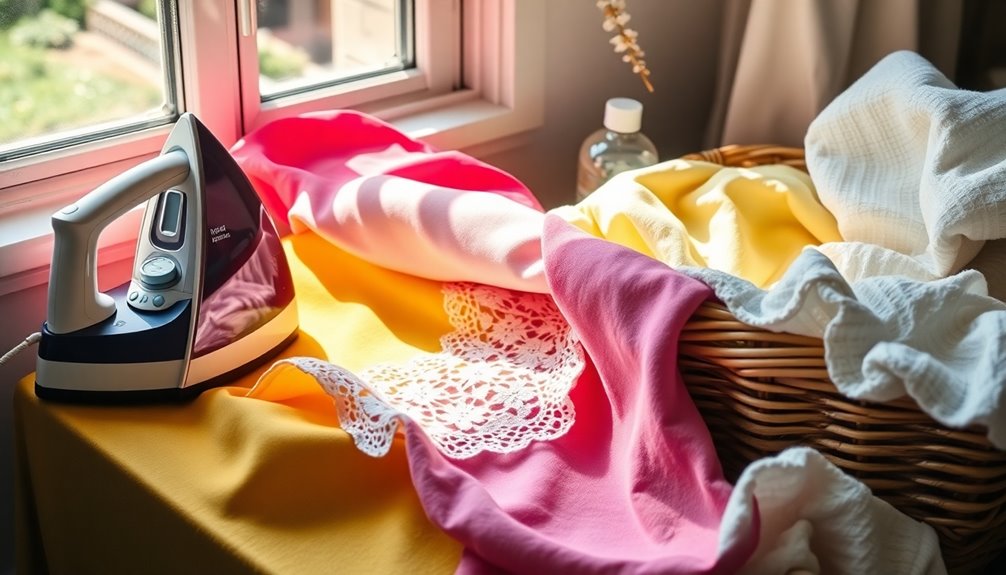To keep your fabrics looking new, start by sorting laundry into whites, colors, and delicates. Always check care labels for washing and drying instructions. Use cold water for delicate items and hot water for heavily soiled pieces. Dry clothes gently, preferably air-drying to avoid shrinkage. Iron inside out and store garments in a cool, dry place. Regularly inspect stored items for pests. Keep following these tips, and you'll discover more secrets to preserving your fabrics.
Key Takeaways
- Always check care labels for specific washing and drying instructions to maintain fabric integrity and appearance.
- Sort laundry by color and fabric type to prevent color bleeding and damage to delicate items.
- Use cold water for washing delicate fabrics and bright colors to prevent fading and shrinking.
- Air dry garments whenever possible to preserve their shape and prevent heat damage from dryers.
- Store clean, dry clothes in a cool, dry place with good ventilation to avoid mold and pests.
Understanding Fabric Types and Care Labels
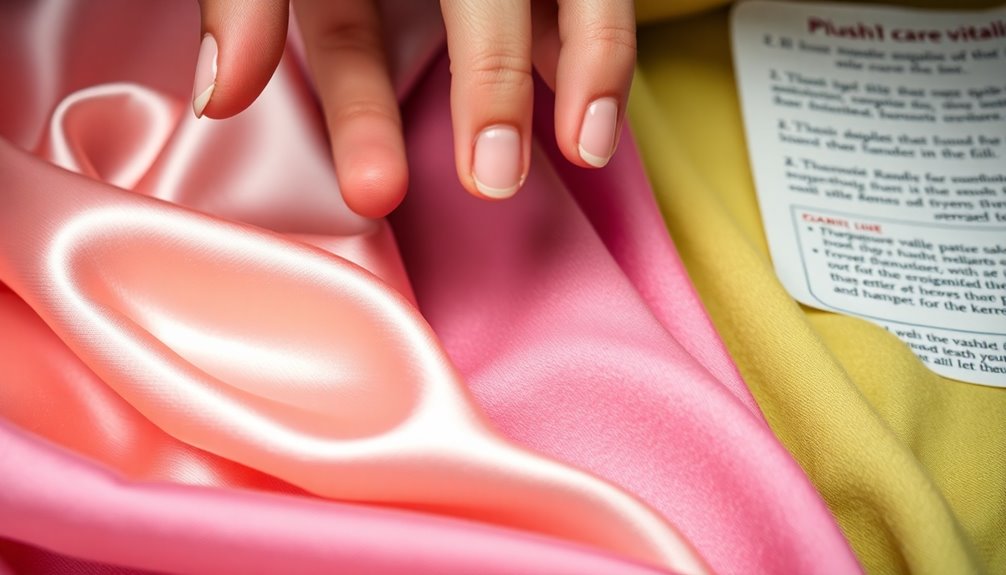
When you understand fabric types and care labels, you can take better care of your clothing and extend its life. Different fabric types, like cotton, silk, wool, and polyester, have unique properties and care requirements.
Care labels are your best friend, providing essential instructions on washing techniques, drying methods, and whether to dry clean or hand wash. Pay attention to fabric care symbols, such as the washing temperature tub and bleach triangle, to avoid mishaps like fading and shrinking.
Natural fibers need gentler handling, while synthetic fibers are more durable and can handle machine washing. By following the recommended care instructions on labels, you guarantee proper care, preserving your garments' texture, color, and fit over time.
Sorting Your Laundry

Sorting your laundry is an essential step in keeping your clothes looking their best. Start by separating items into categories like whites, colors, and darks to prevent color bleeding and maintain brightness.
Organize your fabrics by type, placing delicate items such as silk and lace in a separate pile to avoid damage during washing. Assess the dirtiness level of your clothes; wash heavily soiled items separately for effective cleaning and to prevent contamination.
Always check the care instructions on labels, as different fabrics have unique washing requirements. For added protection, consider using mesh laundry bags for delicate items to prevent snagging and guarantee they remain in great condition.
Taking these steps will help your laundry stay fresh and vibrant!
Choosing the Right Detergent

When choosing detergent, you should look for a mild formula that works well with various fabrics to prevent damage.
Consider eco-friendly options that are gentle on both your clothes and the environment.
Remember to follow the manufacturer's instructions to avoid any residue build-up in your washing machine.
Mild Detergent Selection
How do you choose the right mild detergent for your laundry? Start by looking for products free from harsh chemicals and dyes, which can harm both your fabrics and sensitive skin.
Opting for a mild detergent helps prevent residue build-up, keeping your clothes feeling soft and looking vibrant. Additionally, consider eco-friendly fabric care options that use biodegradable ingredients, making them gentler on the environment and your garments.
Always check the care labels on your clothes to verify compatibility with the detergent you select. Remember, using too much detergent won't improve cleaning power and can lead to fabric discoloration and soap scum build-up. Stick to the recommended amounts for the best results.
Eco-Friendly Options
Choosing eco-friendly detergent options not only benefits your clothes but also helps protect the planet. When selecting a gentle detergent, look for biodegradable detergents that are free from phosphates, sulfates, and artificial fragrances. These options guarantee a softer impact on both your fabrics and the environment.
Check for eco-friendly certifications, like the EPA's Safer Choice label, which assures the product meets strict health and environmental criteria. Plant-based detergents often contain fewer harsh chemicals, making them ideal for sensitive skin.
Additionally, consider using concentrated detergents; they require less packaging and water, reducing waste and your carbon footprint. Remember to use the recommended amount to maintain fabric integrity and enhance cleaning effectiveness. Your choices matter! Furthermore, using eco-friendly products aligns with the principle of savings goals, allowing you to save money while contributing positively to the environment.
Avoiding Residue Build-Up
To avoid residue build-up on your clothes, selecting the right detergent is crucial.
Opt for a mild detergent free from harsh chemicals to effectively clean your fabrics while helping to prevent residue build-up. Remember, using too much detergent can lead to accumulation, so always follow the recommended dosage on the packaging.
Consider eco-friendly detergents, as they're often formulated to reduce residue and are gentler on both your clothes and the environment.
Before committing to a new detergent, test it on small fabric swatches to verify compatibility and effectiveness.
Finally, don't forget to clean your washing machine regularly to prevent any leftover detergent from transferring back onto your clothes, keeping them fresh and clean.
Washing Machine Tips
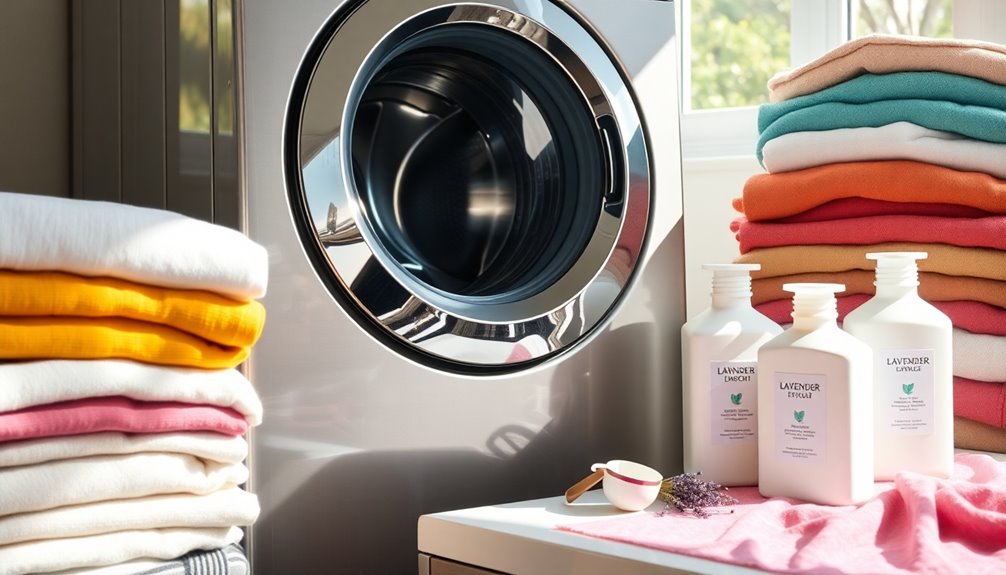
When it comes to washing your clothes, selecting the right water temperature is key to keeping them in great shape.
Turning garments inside out and using a gentle cycle for delicates can help preserve their color and texture.
Optimal Water Temperature Selection
While you might think that all clothes can be washed the same way, selecting the best water temperature is essential for maintaining the quality of your fabrics.
Here's a quick guide for ideal water temperature selection:
- Cold Water (60°F or below): Perfect for delicate fabrics and bright colors to prevent fading and shrinking.
- Warm Water (90°F to 110°F): Best for most everyday fabrics like cotton and polyester, effectively removing dirt without damaging them.
- Hot Water (130°F or above): Use for heavily soiled items like towels and bed linens, as it eliminates bacteria and allergens. Additionally, using HEPA filters in your vacuum cleaner can help remove allergens from fabrics in your home.
Inside-Out Washing Technique
Protecting your clothes during the wash is essential, and one effective method is the inside-out washing technique. By turning your garments inside out, you can notably reduce friction, minimizing wear on the fabric's exterior.
This is especially important for delicate fabrics, as it helps preserve their color and texture. For printed or embellished items, this technique shields designs from fading and damage in the wash cycle.
Additionally, washing inside out can prevent pilling, keeping your clothes looking newer for longer. If your items have zippers or buttons, turning them inside out also helps prevent snagging on other fabrics, reducing the risk of damage to both your garments and the washing machine.
Gentle Cycle for Delicates
Choosing the gentle cycle on your washing machine can be a game-changer for maintaining the integrity of delicate fabrics. This setting uses slower agitation and shorter wash times, which minimizes wear and tear.
Remember these tips for proper fabric care:
- Always turn delicate garments inside out to reduce friction.
- Use a mesh laundry bag to prevent snagging and entanglement.
- Check care labels for specific instructions before washing.
Most gentle cycles operate with cold or lukewarm water, helping to prevent shrinking and fading. Additionally, consistent maintenance of your washing machine can enhance its performance and longevity.
Drying Your Clothes
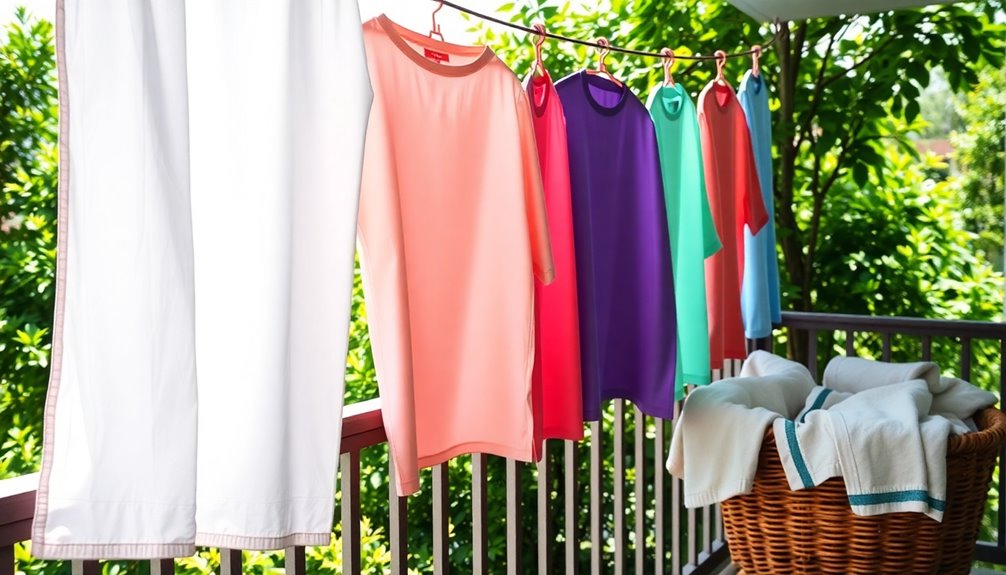
Properly drying your clothes is essential to maintaining their quality and extending their lifespan. Air drying is highly recommended as it preserves fabric integrity and prevents damage from high heat, which can weaken fibers over time.
If you use a dryer, always select the lowest heat setting to minimize shrinkage and keep your garments fitting correctly. To avoid wrinkles, promptly fold or hang clothes right after they’re dry; leaving them in the dryer can lead to creasing. Additionally, it’s important to pay attention to the fabric blends when washing your clothes. Many people wonder, “does cotton polyester fabric shrink,” and while it generally resists shrinking more than 100% cotton, it’s still wise to take precautions. Always read the care labels on your garments to ensure you are following the recommended washing and drying instructions for the best results.
Delicate fabrics should be dried flat on a clean, dry surface to maintain their shape and prevent stretching.
Finally, verify clothes are completely dry before storing them to avoid mold growth and unpleasant odors, especially in humid environments.
Ironing and Steaming
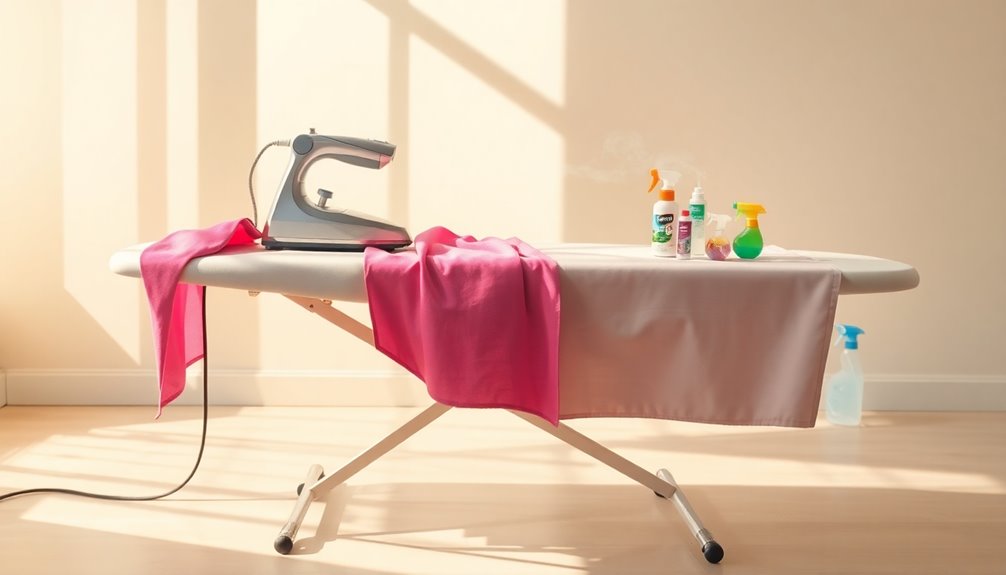
After you've dried your clothes, the next step is tackling wrinkles with effective ironing or steaming techniques. Here are some tips to keep in mind:
- Always check care labels for appropriate heat settings.
- Use a steamer for delicate fabrics like silk and lace.
- Iron clothes inside out to protect embellishments.
Ensure your ironing surface is smooth and padded for even heat distribution.
Regularly clean your iron's plate to prevent stains from residue buildup.
By following these practices, you can maintain your clothes' appearance and extend their life.
Remember, using the right method for each fabric type not only helps with wrinkles but also protects your garments from potential damage.
Happy ironing!
Storage Solutions

Effective storage solutions can greatly extend the life of your clothes and keep them looking their best. To prevent mold and mildew, always store your garments in a cool, dry place with good ventilation, especially for natural fibers like cotton and wool.
Avoid overcrowding your storage spaces; guarantee there's enough room for air circulation around your clothes. For delicate items, use acid-free tissue paper when folding to maintain their shape and prevent creasing.
When it comes to long-term storage, opt for breathable garment bags instead of plastic, which can trap moisture and lead to deterioration.
Regularly inspect your stored items for pests or damage, and refresh them by airing out every few months to maintain their condition.
Preventing Common Fabric Issues
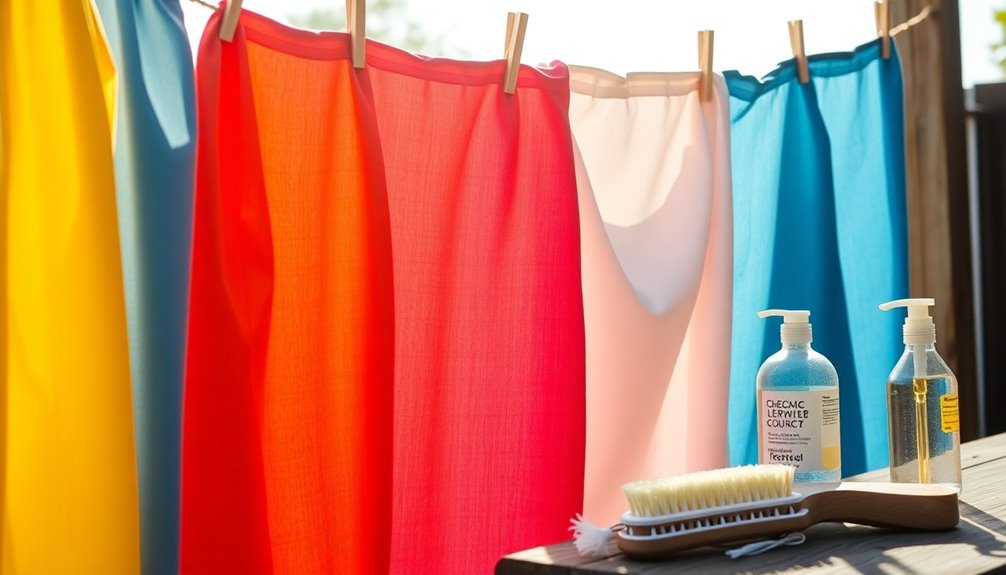
While you may not think about it often, taking proactive steps to prevent common fabric issues can save you time and money in the long run.
Here are some essential tips:
- Always wash fabrics in cold water to prevent shrinking and fading.
- Store garments properly, ensuring they're clean and dry to avoid mold.
- Regularly remove pilling and avoid abrasive surfaces to minimize wear and tear.
Frequently Asked Questions
How Do You Make Fabric Look New?
To make fabric look new, start by washing it according to the care label, using mild detergents and appropriate temperatures.
Air dry delicate items and use low heat for sturdier fabrics.
Store your clothes in a cool, dry place, ensuring they're clean and completely dry to prevent mold.
Treat stains promptly with gentle methods, and when ironing, use the correct temperature for each fabric type to maintain their appearance.
What Is the Best Way to Preserve Fabric?
To preserve fabric, you've gotta treat it right.
Start by washing and drying according to care labels—cool water and low heat do wonders.
Store your items in a cool, dry place with ventilation; tossing in some acid-free tissue can help, too.
Use mild, eco-friendly detergents to keep colors vibrant.
Don't forget to tackle stains quickly and check for wear regularly; a little maintenance goes a long way in keeping your fabrics fresh!
How to Care for Every Type of Fabric?
To care for every type of fabric, start by understanding their specific needs.
For cotton, machine wash in warm or cold water, and air dry.
Silk requires gentle hand washing in cold water; avoid soaking.
Wool needs cool water and special detergent, with reshaping while flat to dry.
Synthetics should be washed on a gentle cycle, while semi-synthetics benefit from cool machine washes.
Always air dry to maintain quality and prevent damage.
What Is the Proper Care and Maintenance of Fabrics?
Imagine your favorite shirt plotting a revolt because you tossed it in with the reds. Proper fabric care's no joke!
Start by sorting laundry—colors, fabric types, dirt levels. Always follow care labels; they're like the secret recipe to keeping your clothes alive.
Use mild detergents and don't overdo it; your fabrics hate residue!
For delicate items, hand wash or use gentle cycles, and don't forget to repair and store them properly!
Conclusion
By following these fabric care tips, you can keep your clothes looking as fresh as a daisy for years to come! Remember, understanding your fabric types and using the right techniques can save your favorite outfits from the dreaded wear and tear. So, sort that laundry, pick the right detergent, and don't forget to store them properly. With a little effort, your wardrobe will feel like it's been plucked straight from a fashion magazine!
